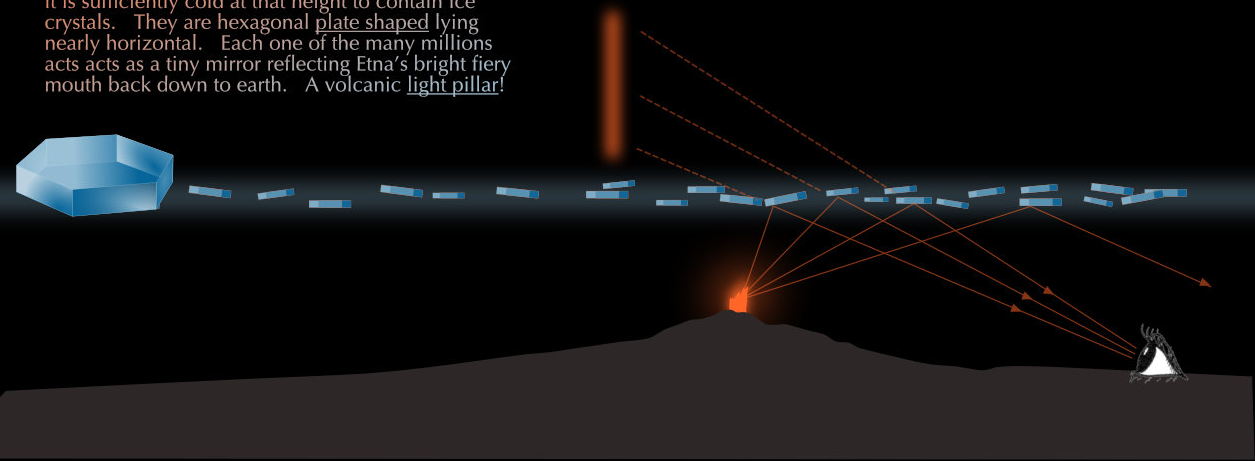Atopics Highlights
Exploring the Wonders of Atmospheric Optics: Atopics Highlights
When it comes to atmospheric optics, there are countless phenomena that can captivate and astonish us. One such mesmerizing spectacle is showcased in Giancarlo Tine's photograph of Sicily's Mount Etna erupting. Amidst the dense smoke and ash, a vivid red shaft of light appears to shoot upwards into the sky. However, the reality behind this awe-inspiring image is perhaps more fascinating than meets the eye.
The ethereal red glow that envelops the scene is not a direct beam of light from the volcano itself. Instead, it is caused by a thin veil of cloud illuminated by Etna's fiery eruption. This cloud layer, which may consist of cirrus clouds or condensation from water vapor ejected by the volcano, is situated at a height where temperatures are cold enough for ice crystals to form. These hexagonal plate-shaped ice crystals, lying almost horizontally, act as tiny mirrors reflecting Etna's fiery mouth back down to Earth. The result? A remarkable atmospheric phenomenon known as a volcanic light pillar.
Intriguingly, the collective reflections from the millions of ice crystals create an illusionary pillar shape that appears to hover above the volcano. While there is no actual beam of light shooting upwards, the sheer number of near optically perfect crystals responsible for this illusion is nothing short of extraordinary. It is a testament to the intricate interplay between light and matter in our atmosphere.
The wobbling motion depicted in the image occurs due to the large size of these crystals. When the cloud layer is deep enough, smaller non-wobbly crystals can also contribute to the formation of a pillar. The precise conditions required for such an atmospheric display are rare and transient, making it all the more captivating when witnessed.
As we delve deeper into the realm of atmospheric optics, it is important to note that the article has been automatically converted from the old site and may not appear exactly as intended. However, the visual representation of the phenomenon remains intact, allowing us to appreciate the wonders of nature.
In conclusion, atmospheric optics never ceases to amaze us with its array of captivating displays. The volcanic light pillar observed in Giancarlo Tine's photograph serves as a testament to the intricate interactions between light, ice crystals, and volcanic activity. By understanding the scientific principles behind these phenomena, we gain a deeper appreciation for the beauty and complexity of our atmosphere. So, next time you find yourself gazing at the sky, remember to keep an eye out for the mesmerizing wonders that atmospheric optics has to offer.

Etna
A scene fit for Lord of the Rings by Giancarlo Tine (Instgm: giancarlotine.photo FBK: giancarlotinephotography).
Sicily's Mount Etna erupts. A lurid red shaft of light shoots from the volcano, pieeces through the dense smoke and ash and on upwards high into the sky.
Or does it? The actuality is perhaps more prosaic. Notice the thin veil of cloud lit dim red by the volcano. It might be cirrus, it might be lower and formed by condesation of water vapour ejected from Etna. Whatever, it is sufficiently cold at that height to contain ice crystals. They are hexagonal plate shaped lying nearly horizontal. Each one of the many millions acts as a tiny mirror reflecting Etna's bright fiery mouth back down to earth. A volcanic light pillar!

The collective reflections (glints) from the crystals form a pillar shape that the eye/brain places over the volcano. It is an illusion - there is no upwards beam of light. But millions of near optically perfect crystals producing that illusion is perhaps more wondrous.
The crystals here are shown as wobbling from an absolute horizontal position. Large crystals do this. If the cloud layer is deep enough a pillar can be formed by smaller non-wobbly crystals.

Note: this article has been automatically converted from the old site and may not appear as intended. You can find the original article here.
Reference Atmospheric Optics
If you use any of the definitions, information, or data presented on Atmospheric Optics, please copy the link or reference below to properly credit us as the reference source. Thank you!
-
<a href="https://atoptics.co.uk/blog/atopics-highlights/">Atopics Highlights</a>
-
"Atopics Highlights". Atmospheric Optics. Accessed on December 18, 2024. https://atoptics.co.uk/blog/atopics-highlights/.
-
"Atopics Highlights". Atmospheric Optics, https://atoptics.co.uk/blog/atopics-highlights/. Accessed 18 December, 2024
-
Atopics Highlights. Atmospheric Optics. Retrieved from https://atoptics.co.uk/blog/atopics-highlights/.